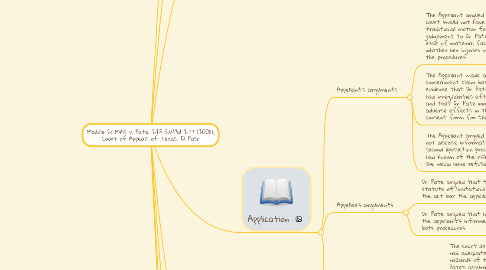
1. Facts
1.1. Parties
1.1.1. Joyceline Mills, Appellant
1.1.2. Dr. John Pate, M.D., Appellee
1.2. What Happened
1.2.1. Mills met with Dr. Pate seeking liposuction and thigh lift. Dr. Pate told the patient that she would look beautiful after the operation.
1.2.2. Mills signed an informed consent document informing her of the possible side effects and possible complications.
1.2.3. After the procedure, Mills followed Pate's post-operation instructions, but noticed irregularities outside of the expected bruising and swelling.
1.2.3.1. Pate informed Mills that having a second surgery would ensure that Mills would have smooth skin with no further irregularities. Mills signed another informed consent form and the second procedure was completed.
1.2.4. Mills was dissatisfied with the second surgery. Mills brought suit against Pate under the Medical Liability and Insurance Improvement Act (MLIIA)
1.3. Procedural History
1.3.1. The 346th District Court, El Paso County granted Dr. Pate a traditional motion for summary judgement and a no-evidence summary judgement.
1.3.2. Mills appealed to the Court of Appeals of Texas, El Paso.
2. Issue
2.1. Whether the summary judgement proof establishes that there is no genuine issue of material fact as to one or more elements of the appellant's claims.
3. Rule of Law
3.1. Legal Principles
3.1.1. Medical Liability and Insurance Improvement Act
3.1.1.1. Statute of Limitations
3.1.1.1.1. There is a 2 year statute of limitations contained in section 10.01 of Article 4590i.
3.1.1.2. Informed Consent
3.1.1.2.1. Risks and hazards inherent in the procedure must be disclosed and agreed to by the patient before conducting the procedure
3.1.1.3. Breach of Express Warranty - Under Statues of Frauds
3.1.1.3.1. Services provided must conform to the character and quality of the services described.
3.1.2. Fraudulent Concealment
3.1.2.1. Suspends the limitations in a medical negligence case until the patient discovers the fraud or could have discovered the fraud with reasonable dilligence
3.1.3. No-Evidence Motion for summary judgement is valid when the evidence does not raise genuine issues of material fact.
3.2. Legal Precedent
3.2.1. Wyatt v. Longoria, 33 S.W.3d 26, 31 (Tex.App.-El Paso 2000, no pet.)
3.2.1.1. The successful movant carried the burden of showing that there is no genuine issue of material fact and that judgment should be granted as a matter of law.
3.2.2. Shah v. Moss, 67 S.W.3d 836, 841 (Tex.2001)
3.2.2.1. The plaintiff may not choose the most favorable date for beginning the statute of limitations. Limitations must begin on the date the alleged tort occurred.
4. Application
4.1. Appellant's arguments
4.1.1. The Appellant argued that the trial court should not have granted traditional motion for summary judgement to Dr. Pate since a genuine issue of material fact exists as to whether her injuries occurred due to the procedures.
4.1.2. The Appellant made a fraudulent concealment claim based on the evidence that Dr. Pate knew that she had irregularities after the surgery and that Dr. Pate modified the list of adverse effects in the informed consent form for the second surgery.
4.1.3. The Appellant argued that Dr. Pate did not disclose information to her to the second liposuction procedure and if she had known of the risks/hazards then she would have refused treatment.
4.2. Appellee's arguments
4.2.1. Dr. Pate argued that the two year statute of limitations referenced in the act bar the appellant's claims.
4.2.2. Dr. Pate argued that he did obtain the appellant's informed consent for both procedures.
4.3. Court's application of the Rule
4.3.1. The court determined that Dr. Pate had adequately disclosed the risks and hazards of the procedures and Dr. Pate's assurances that the second surgery would fix the irregularities caused by the first surgery did not create a genuine issue of material fact.
4.3.2. The court determined that the appellant presented probative evidence to support the elements of her breach of warranty claim.
4.3.3. The court determined that the appellant knew of the irregularities resulting from the first procedure six months after the procedure. Therefore the appellant's fraudulent concealment claim does not stand.

